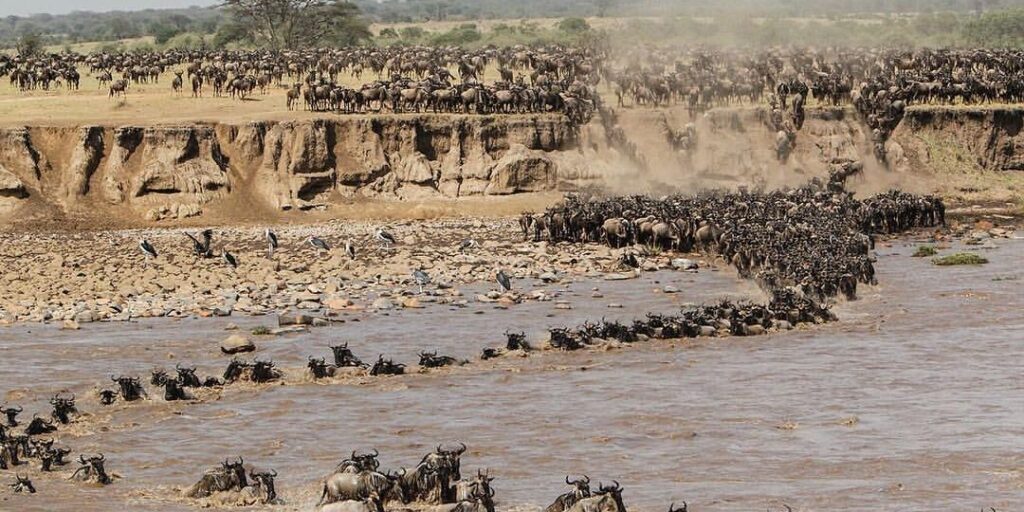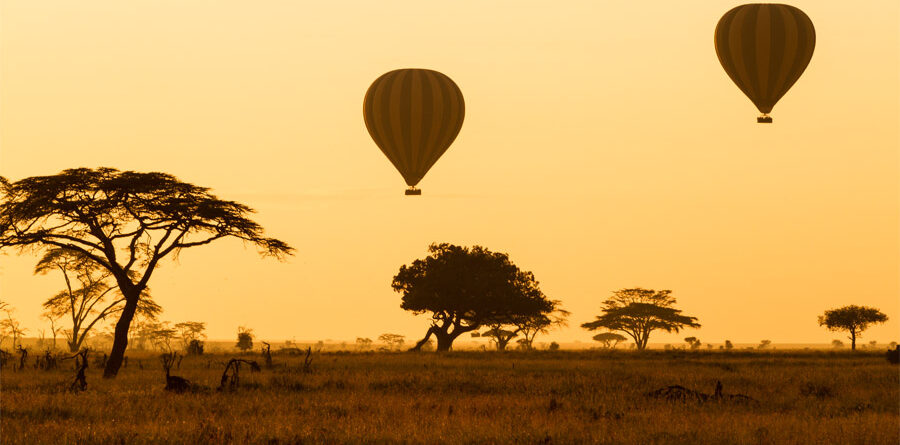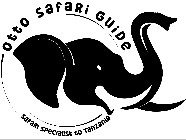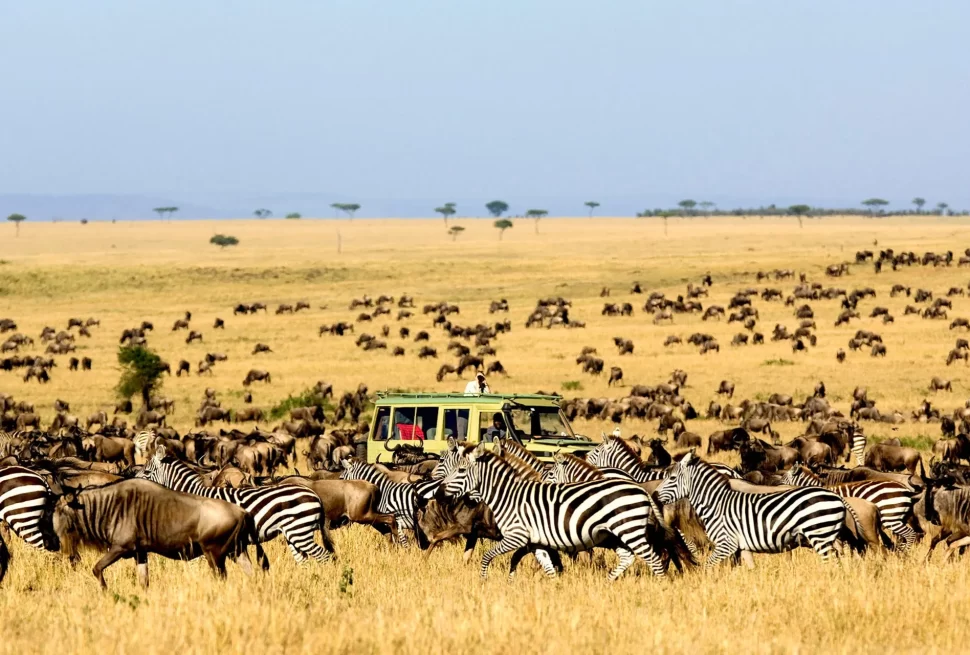The Great Migration is one of the most spectacular wildlife events on Earth, with over 1.5 million wildebeest, 200,000 zebras, and thousands of gazelles moving across Tanzania and Kenya in search of fresh grazing land. This massive movement is a cycle of life, survival, and dramatic predator encounters, making it a bucket-list experience for safari lovers.
✔ Where does the Great Migration happen? Serengeti (Tanzania) & Maasai Mara (Kenya).
✔ When is the best time to see it? Depends on what part of the migration you want to witness!
✔ What can you expect? River crossings, calving season, and intense predator action.
This guide breaks down the migration cycle, best viewing months, top locations, and travel tips to help you plan the perfect Great Migration safari.
1. What is the Great Migration?
✔ A continuous cycle of wildebeest, zebras, and gazelles moving across Tanzania and Kenya.
✔ Driven by rain patterns and food availability—they follow the green grass!
✔ Predators like lions, cheetahs, and crocodiles follow the herds for hunting opportunities.
✔ Tip: The migration never stops—there’s always action happening somewhere!
2. The Great Migration Route – Month-by-Month Breakdown
| Month | Where Are the Herds? | Key Events | Best Safari Location |
|---|---|---|---|
| January – March | Southern Serengeti (Ndutu & Ngorongoro) | Calving season – thousands of wildebeest born, predator action | Ndutu Plains, Ngorongoro Conservation Area |
| April – May | Central Serengeti | Herds start moving north, best green season scenery | Seronera (Central Serengeti) |
| June – July | Western & Northern Serengeti | Grumeti River crossing, predators lurking | Grumeti Reserve, Northern Serengeti |
| August – September | Northern Serengeti & Maasai Mara | Mara River crossing – dramatic crocodile attacks | Kogatende (Serengeti), Maasai Mara (Kenya) |
| October – November | Maasai Mara → Serengeti | Herds start returning to Tanzania, scattered groups | Northern & Central Serengeti |
| December | Southern Serengeti (Ndutu) | Herds arrive back, preparing for calving season | Ndutu Plains, Ngorongoro |
✔ Tip: For dramatic river crossings, visit in July–September.
✔ For calving season with predator action, go in January–March.
3. Best Places to Witness the Great Migration
📍 Southern Serengeti & Ndutu Plains (January–March) – Calving Season
✔ Why Visit? 500,000 wildebeest calves are born in 3 weeks!
✔ Predator Action: Lions, cheetahs, hyenas hunting newborns.
✔ Best Lodges:
- Serengeti Safari Camp – Mobile tented camp following the migration.
- Ndutu Safari Lodge – Close to calving areas, good for photographers.
✔ Tip: Best for photography & predator action lovers.
📍 Grumeti River (June–July) – First Major River Crossing
✔ Why Visit? Herds cross the crocodile-infested Grumeti River in western Serengeti.
✔ Predator Action: Nile crocodiles, lions, leopards waiting for weak prey.
✔ Best Lodges:
- Singita Grumeti Reserves – Luxury, private access to river crossings.
- Serengeti Serena Lodge – Good location & value.
✔ Tip: Less crowded than the famous Mara River crossings.
📍 Mara River (July–September) – The Most Dramatic River Crossing
✔ Why Visit? The most thrilling and dangerous migration event—thousands of animals crossing at once.
✔ Predator Action: Crocodiles ambush herds, lions wait on the banks.
✔ Best Lodges:
- Sayari Camp (Northern Serengeti) – Close to prime crossing points.
- Serengeti Bushtops – Luxury, incredible migration views.
✔ Tip: Book at least 6–12 months in advance—this is the most popular migration season!
📍 Maasai Mara (August–October) – Wildebeest in Kenya
✔ Why Visit? The herds spread across Kenya’s Maasai Mara.
✔ Predator Action: Lions & cheetahs hunt in open grasslands.
✔ Best Lodges:
- Angama Mara – Incredible views over the plains.
- Governors’ Camp – Iconic location with great wildlife access.
✔ Tip: Perfect for travelers who want shorter safari drives and great wildlife density.


4. How to Plan a Great Migration Safari
✔ Book Early! Lodges & camps fill up 6–12 months in advance, especially in July–September.
✔ Choose a Mobile Camp – These camps move with the migration, so you’re always close to the action.
✔ Consider a Private Safari – A private guide & vehicle allows flexibility to follow the herds.
✔ Fly Between Parks – Serengeti is huge—fly-in safaris save long road travel time.
✔ Tip: The best safari duration is 7–10 days to ensure you see major migration highlights.
5. Great Migration Safari Costs – How Much to Budget?
| Safari Type | Cost Per Person (Per Day) | Includes |
|---|---|---|
| Budget Safari | $200 – $500 | Shared vehicle, basic lodges |
| Mid-Range Safari | $500 – $1,200 | Comfortable lodges, some private game drives |
| Luxury Safari | $1,500 – $3,500+ | Private vehicle, top lodges, fly-in access |
✔ Tip: Budget travelers can visit in March or November, when prices are lower.
6. Frequently Asked Questions (FAQs) About the Great Migration
Q1: When is the best time to visit the Serengeti for the Great Migration?
✔ July–September for Mara River crossings.
✔ January–March for calving season & predator action.
Q2: Can I see the Great Migration year-round?
✔ Yes! The herds are always moving—choose your travel dates based on the event you want to see.
Q3: Is the Great Migration dangerous for tourists?
✔ No! Safaris are well-organized and safe, with expert guides keeping you at a secure distance.
Q4: Do I need a visa for Tanzania or Kenya?
✔ Yes, most travelers require a Tanzania or Kenya visa—apply online before traveling.
Conclusion: Witness the Greatest Wildlife Show on Earth
The Great Migration is a must-see safari experience, whether you want to witness the intense Mara River crossings or the adorable calving season.
✔ For predator action: Go in January–March (calving season).
✔ For river crossings: Travel July–September (Mara River).
✔ For fewer crowds & savings: Visit in March or November.
Ready to Book Your Great Migration Safari?
Contact us today for custom itineraries & expert guidance on planning your migration adventure!




